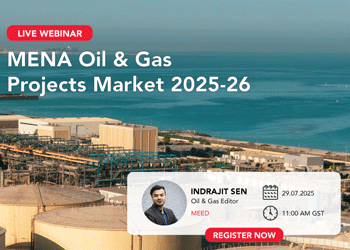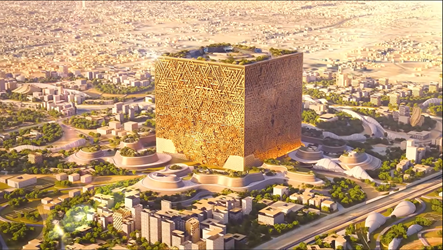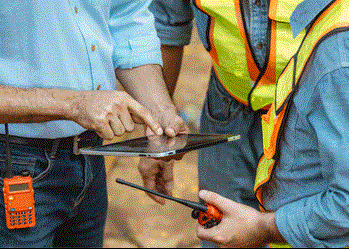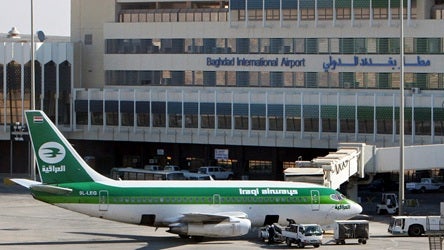Investing in Saudi Arabia’s infrastructure opportunities
2 April 2025

Register for MEED’s 14-day trial access
With a background in private banking and asset management, Edmond de Rothschild is an established player in infrastructure investment. Since launching its infrastructure platform in 2014, the firm has raised over $6.5bn, ranking among Europe’s top infrastructure debt investors.
 The bank prides itself on a conviction-led approach. “We at Edmond de Rothschild are a company that has convictions. Private markets are not a broad, generalist approach for us; we adopt a highly focused strategy, particularly in infrastructure,” says Jean-Francis Dusch, CEO of Edmond de Rothschild Asset Management UK and global head of infrastructure and structured finance.
The bank prides itself on a conviction-led approach. “We at Edmond de Rothschild are a company that has convictions. Private markets are not a broad, generalist approach for us; we adopt a highly focused strategy, particularly in infrastructure,” says Jean-Francis Dusch, CEO of Edmond de Rothschild Asset Management UK and global head of infrastructure and structured finance.
This strategic approach has allowed Edmond de Rothschild to establish itself as a key player in infrastructure finance, growing from a small team of fewer than 10 people in 2014 to one that has now raised billions in capital. “We decided to focus first on real estate, then private equity with very specific strategies, and finally infrastructure, where we maintain a global approach,” says Dusch.
Edmond de Rothschild initially engaged in advisory services for governments and private consortiums, providing expertise in project implementation. The firm’s work in the public-private partnership (PPP) space led to the development of a dedicated infrastructure lending platform. “In less than 10 months from the initial idea being discussed, we raised $400m. Fast forward to today, and we have now raised more than $6.5bn, positioning us as a major player in infrastructure debt,” says Dusch.
Saudi infrastructure
Saudi Arabia’s Vision 2030 has set the stage for significant infrastructure development, and Edmond de Rothschild is positioning itself to play a crucial role. “Saudi Arabia is already the largest infrastructure market in the region, and we see significant opportunities to contribute,” says Dusch.
A major part of Edmond de Rothschild’s approach focuses on debt financing rather than equity. “The platform I represent is dedicated to debt. There has been a lot of equity investment from the kingdom and the strong regional banks, as well as large global banks. However, as infrastructure investment accelerates, we anticipate a liquidity gap that we can help bridge,” says Dusch.
This is particularly relevant given Saudi Arabia’s ambitious infrastructure programmes. “With Vision 2030 driving development, the need for private liquidity will increase. Our goal is to provide that liquidity in a structured way, supporting sustainable capital structures while ensuring robust returns for investors,” he says.
To reinforce its commitment, Edmond de Rothschild has established a local joint venture in Saudi Arabia.
The firm takes a diversified approach to infrastructure, ensuring it remains at the forefront of evolving sector trends. “Ten years ago, infrastructure was primarily about transport and social infrastructure,” says Dusch. “But we have always believed it also includes renewable energy, digital infrastructure and decarbonisation efforts.”
The shift toward digital infrastructure has been particularly notable. “The rise of AI and data-driven technologies has increased demand for digital infrastructure. Sustainable data centres, fibre optics and digital connectivity are becoming key pillars of modern infrastructure investment,” says Dusch.
Edmond de Rothschild’s portfolio comprises a mix of greenfield and brownfield infrastructure projects. “As a project financier, our natural inclination is to focus on new projects. However, when managing
investor capital, we also look at brownfield projects that require modernisation. About 30% of our portfolio is greenfield, and 70% is brownfield,” says Dusch.
This focus aligns with the evolving nature of infrastructure investment. “Assets need to be modernised,
especially in energy transition and digitalisation,” he says. “Many brownfield projects are still in a growth phase, so while they are technically existing assets, they require significant new investment.”
Broader region
While Saudi Arabia is the focus, Edmond de Rothschild is also eyeing broader regional expansion. “Our goal is to develop a multibillion-dollar infrastructure programme in the region, as we did in Europe. The first step is Saudi Arabia, where we have strong local partners. However, we aim to expand our coverage to other GCC countries over time,” says Dusch.
We don’t need to do everything – we focus on areas where we can add real value
This approach mirrors the firm’s European expansion strategy. “In Europe, we started with a focused mandate in core markets and gradually expanded,” he says. “We plan to follow a similar trajectory in the Middle East, leveraging our experience and track record to drive growth.”
One of the critical questions for international investors is whether Saudi projects are investment-ready. “It’s a mix,” he acknowledges. “Like in Europe, large programmes are announced, and while not every project is immediately ready, there is a concrete pipeline of opportunities.”
Edmond de Rothschild sees particular potential in small to mid-sized projects. “The debt instruments we offer are currently more suited to small and medium-sized projects rather than megaprojects. However, as the market evolves, we anticipate broader participation,” he says.
Saudi Arabia’s infrastructure financing model is also undergoing a shift. “Previously, infrastructure was largely government-led with a first-generation PPP approach. Now, we are seeing more private sector initiatives. Europe has largely transitioned to private infrastructure development, and Saudi Arabia is following a similar path,” says Dusch.
Long-term commitment
With infrastructure demand growing across sectors, Edmond de Rothschild will remain selective with its strategy. “We don’t need to do everything – we focus on areas where we can add real value. That is what has made us successful, and that’s the approach we will continue in Saudi Arabia and beyond.”
Hear directly from the gigaproject owners at the biggest construction event—The Saudi Giga Projects 2025 Summit, happening in Riyadh from 12-14 May 2025. Click here to know more
MEED’s April 2025 report on Saudi Arabia includes:
> GOVERNMENT: Riyadh takes the diplomatic initiative
> ECONOMY: Saudi Arabia’s non-oil economy forges onward
> BANKING: Saudi banks work to keep pace with credit expansion
> UPSTREAM: Saudi oil and gas spending to surpass 2024 level
> DOWNSTREAM: Aramco’s recalibrated chemical goals reflect realism
> POWER: Saudi power sector enters busiest year
> WATER: Saudi water contracts set another annual record
> CONSTRUCTION: Reprioritisation underpins Saudi construction
> TRANSPORT: Riyadh pushes ahead with infrastructure development
> DATABANK: Saudi Arabia’s growth trend heads up
Exclusive from Meed
-
 WEBINAR: Mena Oil & Gas Projects Market 2025-26
WEBINAR: Mena Oil & Gas Projects Market 2025-2610 July 2025
-

-
 Chinese firm wins Mid Island Parkway tunnelling deal
Chinese firm wins Mid Island Parkway tunnelling deal10 July 2025
-
 Iraq tenders Baghdad airport PPP project
Iraq tenders Baghdad airport PPP project9 July 2025
-

All of this is only 1% of what MEED.com has to offer
Subscribe now and unlock all the 153,671 articles on MEED.com
- All the latest news, data, and market intelligence across MENA at your fingerprints
- First-hand updates and inside information on projects, clients and competitors that matter to you
- 20 years' archive of information, data, and news for you to access at your convenience
- Strategize to succeed and minimise risks with timely analysis of current and future market trends

Related Articles
-
 WEBINAR: Mena Oil & Gas Projects Market 2025-26
WEBINAR: Mena Oil & Gas Projects Market 2025-2610 July 2025
Date & Time: Tuesday 29 July 2025 | 11:00 AM GST
Agenda:
1. Summary of the Mena oil, gas and petrochemicals projects market
2. Summary description of the main megaprojects, including project programmes
3. Analysis of active contracts and spending to date
4. Analysis of top contracts by work already awarded
5. Long-term capital expenditure outlays and forecasts
6. Highlights of key contracts to be tendered and awarded over the next 18 months
7. Top contractors and clients
8. Breakdown of spending by segment, ie, oil, gas, petrochemicals – upstream, downstream, onshore and offshore
9. Q&A session
https://image.digitalinsightresearch.in/uploads/NewsArticle/14241705/main.gif -
 New Murabba signs up South Korean firm for design works
New Murabba signs up South Korean firm for design works10 July 2025
Register for MEED’s 14-day trial access
Saudi Arabia’s New Murabba Development Company (NMDC) has signed a memorandum of understanding (MoU) with South Korea’s Heerim Architects & Planners to explore further design works on assets at the 14 square-kilometre New Murabba downtown project.
According to an official statement: “Heerim Architects & Planners will explore distinctive architectural plans that complement the development’s masterplan, with special focus on anchor assets, linear parks and smart city features.”
New Murabba CEO Michael Dyke signed the agreement last week during the company’s Investment and Partnership Forum in Seoul.
At the event, NMDC also signed an MoU with South Korea’s Naver Cloud Corporation to explore technological solutions for delivering the New Murabba downtown project.
According to an official statement: “The three-year agreement covers exploring innovative technology and automation to support the delivery of New Murabba, including robotics, autonomous vehicles, a smart city platform and digital solutions for monitoring construction progress.”
NMDC is in Seoul to examine technological offerings, assess financing options and showcase the investment opportunities available for the New Murabba downtown development.
The statement added that the excavation works for The Mukaab, the centrepiece of the overall development, have now been completed.
The Mukaab is a Najdi-inspired landmark that will be one of the largest buildings in the world. It will be 400 metres high, 400 metres wide and 400 metres long. Internally, it will have a tower on top of a spiral base and a structure featuring 2 million square metres (sq m) of floor space designated for hospitality. It will feature commercial spaces, cultural and tourist attractions, residential and hotel units, and recreational facilities.
Downtown destination
The New Murabba destination will have a total floor area of more than 25 million sq m and feature more than 104,000 residential units, 9,000 hotel rooms and over 980,000 sq m of retail space.
The scheme will include 1.4 million sq m of office space, 620,000 sq m of leisure facilities and 1.8 million sq m of space dedicated to community facilities.
The project will be developed around the concept of sustainability and will include green spaces and walking and cycling paths to promote active lifestyles and community activities.
The living, working and entertainment facilities will be developed within a 15-minute walking radius. The area will use an internal transport system and will be about a 20-minute drive from the airport.
The downtown area will feature a museum, a technology and design university, an immersive, multipurpose theatre, and more than 80 entertainment and cultural venues.
 READ THE JULY 2025 MEED BUSINESS REVIEW – click here to view PDF
READ THE JULY 2025 MEED BUSINESS REVIEW – click here to view PDFUAE and Turkiye expand business links; Renewed hope lies on the horizon for trouble-beset Levant region; Gulf real estate momentum continues even as concerns emerge
Distributed to senior decision-makers in the region and around the world, the July 2025 edition of MEED Business Review includes:
> AGENDA: UAE-Turkiye trade gains momentum> INTERVIEW 1: Building on UAE-Turkiye trade> INTERVIEW 2: Turkiye's Kalyon goes global> INTERVIEW 3: Strengthening UAE-Turkiye financial links> INTERVIEW 4: Turkish Airlines plans further growth> CURRENT AFFAIRS: Middle East tensions could reduce gas investments> GCC REAL ESTATE: Gulf real estate faces a more nuanced reality> PROJECTS MARKET: GCC projects market collapses> INTERVIEW 5: Hassan Allam eyes role in Saudi Arabia’s transformation> INTERVIEW 6: Aseer region seeks new investments for Saudi Arabia> LEADERSHIP: Nuclear power makes a global comeback> LEVANT MARKET FOCUS: Levant states wrestle regional pressures> GULF PROJECTS INDEX: Gulf projects index continues climb> CONTRACT AWARDS: Mena contract award activity remains subdued> ECONOMIC DATA: Data drives regional projects> OPINION: A farcical tragedy that no one can endTo see previous issues of MEED Business Review, please click herehttps://image.digitalinsightresearch.in/uploads/NewsArticle/14239016/main.jpg -
 Chinese firm wins Mid Island Parkway tunnelling deal
Chinese firm wins Mid Island Parkway tunnelling deal10 July 2025

Register for MEED’s 14-day trial access
Beijing-headquartered China Railway Tunnel Engineering Group has won a $60m subcontract for the tunnelling works on package 1B of the Mid Island Parkway project in Abu Dhabi.
Package 1B entails the construction of a cut-and-cover tunnel to cross the Khor Laffan Channel, which is the area between the Saadiyat and Um-Yifeenah islands.
The tunnel, which will be between 900 metres and 1 kilometre (km) long, is being constructed on a design-and-build basis and will tie in to packages 1A and 1C.
The project is being jointly constructed by a joint venture of local firm Yas Projects (Alpha Dhabi Holding) and Beijing-based China Railway International Group.
In June last year, MEED exclusively reported that Abu Dhabi's Department of Municipality & Transport had awarded contracts for three packages for phase one of the Mid Island Parkway Project (MIPP), as part of the Plan Capital urban evolution programme.
Phase one will start at the existing Saadiyat Interchange, which will connect the E12 road to the MIPP, and will end with the recently constructed Um-Yifeenah Highway.
It comprises a dual main road with a total length of 8km, including four traffic lanes in each direction, two interchanges, a tunnel and associated infrastructure works.
MIPP phase one is further divided into packages 1A, 1B and 1C, which were awarded separately.
The project ownership has been transferred from Aldar Properties to Abu Dhaibi's Department of Municipalities & Transport.
Previously, it was transferred from Abu Dhabi General Services Company (Musanada) to Aldar Properties, and the project was included in the Abu Dhabi Investment Office's public-private partnership project pipeline.
 READ THE JULY 2025 MEED BUSINESS REVIEW – click here to view PDF
READ THE JULY 2025 MEED BUSINESS REVIEW – click here to view PDFUAE and Turkiye expand business links; Renewed hope lies on the horizon for trouble-beset Levant region; Gulf real estate momentum continues even as concerns emerge
Distributed to senior decision-makers in the region and around the world, the July 2025 edition of MEED Business Review includes:
> AGENDA: UAE-Turkiye trade gains momentum> INTERVIEW 1: Building on UAE-Turkiye trade> INTERVIEW 2: Turkiye's Kalyon goes global> INTERVIEW 3: Strengthening UAE-Turkiye financial links> INTERVIEW 4: Turkish Airlines plans further growth> CURRENT AFFAIRS: Middle East tensions could reduce gas investments> GCC REAL ESTATE: Gulf real estate faces a more nuanced reality> PROJECTS MARKET: GCC projects market collapses> INTERVIEW 5: Hassan Allam eyes role in Saudi Arabia’s transformation> INTERVIEW 6: Aseer region seeks new investments for Saudi Arabia> LEADERSHIP: Nuclear power makes a global comeback> LEVANT MARKET FOCUS: Levant states wrestle regional pressures> GULF PROJECTS INDEX: Gulf projects index continues climb> CONTRACT AWARDS: Mena contract award activity remains subdued> ECONOMIC DATA: Data drives regional projects> OPINION: A farcical tragedy that no one can endTo see previous issues of MEED Business Review, please click herehttps://image.digitalinsightresearch.in/uploads/NewsArticle/14238039/main3047.gif -
 Iraq tenders Baghdad airport PPP project
Iraq tenders Baghdad airport PPP project9 July 2025
Register for MEED’s 14-day trial access
Iraq’s Ministry of Transport and the General Company for Airport & Air Navigation Services have released a tender inviting firms to bid for a contract to develop Baghdad International airport on a public-private partnership (PPP) basis.
The notice was issued in July, and the submission deadline is in September.
According to an official statement posted on its website, Iraq’s Ministry of Transport said that 10 out of 14 international consortiums that expressed interest in the project earlier this year have been prequalified to compete for the tender.
The scope of the estimated $400m-$600m project involves rehabilitating, expanding, financing, operating and maintaining the airport. It is the first airport PPP project to be launched in Iraq.
The initial capacity of the airport is expected to be around 9 million passengers, which will be gradually increased to 15 million passengers.
The International Finance Corporation (IFC), a member of the World Bank Group, is the project’s lead transaction adviser.
Iraq is already developing the Baghdad and Najaf-Karbala metro projects using a similar PPP model.
Earlier this month, MEED reported that Iraq intends to retender the contract to develop and operate the Baghdad Metro project, following the award of the estimated $2.5bn contract last year.
According to local media reports, Nasser Al-Assadi, adviser to Prime Minister Mohammed Sudani, stated that the previous developers had overestimated the project budget; therefore, the government will relaunch the entire process to implement the project.
https://image.digitalinsightresearch.in/uploads/NewsArticle/14229008/main.jpg -
 Contractors prepare revised bids for Roshn stadium
Contractors prepare revised bids for Roshn stadium9 July 2025

Register for MEED’s 14-day trial access
Saudi gigaproject developer Roshn has invited firms to submit revised commercial proposals by 24 July for a contract to build a new stadium adjacent to the National Guard facilities to the southwest of Riyadh.
Known as the National Guard Stadium, it will be delivered on an early contractor involvement (ECI) basis. It will cover an area of over 450,000 square metres and be able to accommodate 46,000 spectators.
The scope of work also covers the construction of auxiliary facilities, including training academy offices and two hotels, as well as retail and food and beverage outlets.
The firms had initially submitted bids on 8 April for the contract.
The stadium is scheduled to host 32 Fifa World Cup tournament games in 2034.
In August last year, MEED reported that Saudi Arabia plans to build 11 new stadiums as part of its bid to host the 2034 Fifa World Cup.
Eight stadiums will be located in Riyadh, four in Jeddah and one each in Al-Khobar, Abha and Neom.
The proposal outlines an additional 10 cities that will host training bases. These are Al-Baha, Jazan, Taif, Medina, Al-Ula, Umluj, Tabuk, Hail, Al-Ahsa and Buraidah.
The bid proposes 134 training sites across the kingdom, including 61 existing facilities and 73 new training venues.
The kingdom was officially selected to host the 2034 Fifa World Cup through an online convention of Fifa member associations at the Fifa congress on 11 December 2024.
 https://image.digitalinsightresearch.in/uploads/NewsArticle/14228507/main.jpg
https://image.digitalinsightresearch.in/uploads/NewsArticle/14228507/main.jpg

